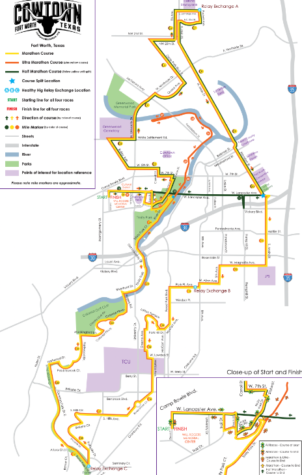Cowtown Marathon weekend: how student runners prepare
Published Feb 22, 2023
Fort Worth residents might want to take a different route to avoid getting snarled in traffic that is delayed by this weekend’s Cowtown Marathon.
Saturday runners will circle around the Cultural District in the 10K, 5K and kids 5K races. Sunday’s marathon and 31.1 mile ultra marathon route will wrap around the TCU campus, while the half marathon will stay further north.
Organizers created an interactive map to help drivers avoid traffic and for supporters looking for the best spot to cheer on runners.

Several TCU students will be joining the stampede of running shoes on Sunday.
Runners have been training for months. Many stick to strict exercise plans and diets.
“I began my training at the beginning of December with three short runs a week that were usually 2 to 3 miles,” said Jessica Parsons, a senior communication studies major. “By the middle of January, the runs went up to about 6 miles, and now in February, I run four times a week with the longest I’ll run before the race being 11 miles.”
Abby Burris, a junior biology and scenic design double major, said she runs 3 to 4 miles twice a week, sprints once a week, runs a 10K once a week and does strength or pilates training the rest of the week.

Rodrigo Cuellar, a junior criminal justice major, is worried he didn’t start training soon enough.
“I have been prepping for Cowtown since the end of December,” he said. “I should’ve started earlier, but I got lazy. If I don’t get the time I want it is because of my lack of training.”
Cuellar, a member of TCU ROTC, said he has been using his running as a substitute for normal Army physical training.
“I aim to run a little over 35 miles a week,” Cueller said. “I also target my upper body muscles by lifting four times throughout the week.”
Runners also watch what they eat.
“Since I am vegetarian, I have definitely been more cognizant of getting my protein in,” said Olivia Sottile, a junior biology major. “It also is more important that I make sure to drink water.”
Cuellar said he has cut down on soda and tried to eat a more balanced diet.
“I sometimes fold and get fast food for dinner,” he said,” but I have been very consistent with only eating a healthy and balanced breakfast along with a loaded sandwich with a protein shake after my lift for lunch.”
Burris said she’s been focusing on getting enough protein.
“I’ve had to force myself to be super intentional about increasing my calorie intake,” she said.


